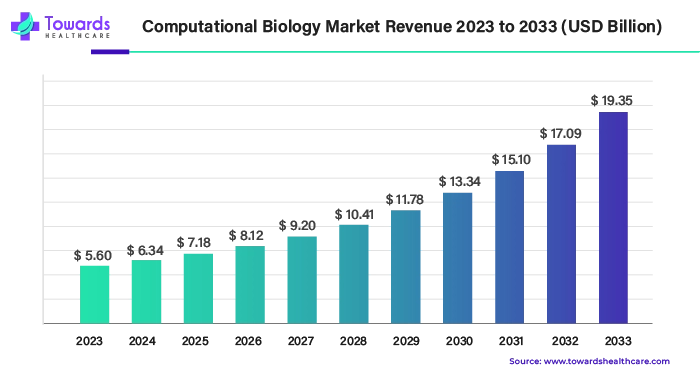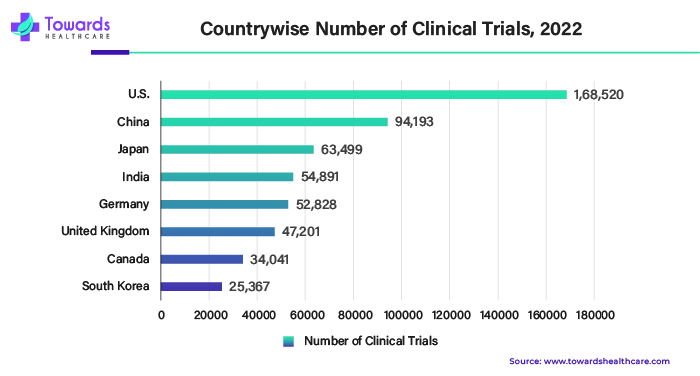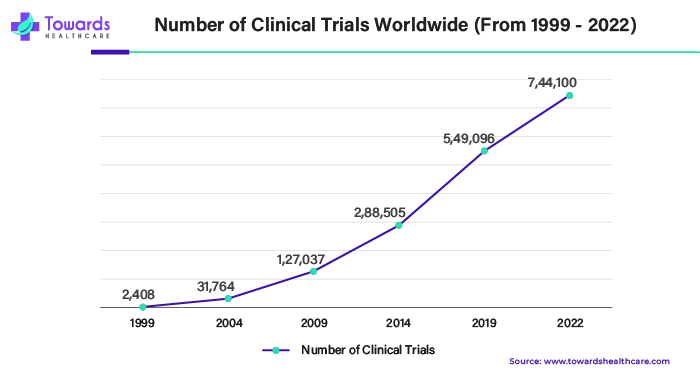February 2025

The global computational biology market size was estimated at US$ 5.60 billion in 2023 and is projected to grow US$ 19.35 billion by 2033, rising at a compound annual growth rate (CAGR) of 13.20% from 2024 to 2033. The market is expanding as a result of significant developments in genomics and bioinformatics, rising demand for personalized medicine, medication research and discovery, and the need for effective data analysis in the life sciences.

Developing and using computational methods to evaluate massive datasets of biological data, including genetic sequences, cell populations, or protein samples, in order to generate novel biological discoveries or make predictions is the multidisciplinary topic of the computational biology market and bioinformatics market. Simulation, mathematical modeling, and analytical techniques are some of the computational techniques employed. Drug development might become more efficient with the use of cutting-edge computing techniques like artificial intelligence, computer-aided drug design, and computational biology, which reduce both the time and cost involved. Several novel pharmaceuticals have been approved for commercialization as a result of the widespread use of computational techniques in recent years to increase the efficacy and effectiveness of drug development and pipeline.
| Company Name | Seed Health |
| Headquarters | Venice, Italy, Europe |
| Recent Launch | In April 2024, CODA, a computational biology tool, was introduced by Seed Health to facilitate the development of microbiome-directed therapies and next-generation precision probiotics. The Human Phenotype Project, which originated in the lab of Weizmann Institute of Science computational biologist Professor Eran Segal, Ph.D., is the world's largest multi-omics data collection and powers the platform. By clarifying hitherto undiscovered relationships between the microbiota and health, CODA facilitates the development of focused, outcome-specific therapies. The first episodes focus on menopause, lifespan, brain health, and cardiometabolic health. |
| Company Name | Xaira Therapeutics |
| Headquarters | Bay Area, California, U.S. |
| Recent Launch | In April 2024, with more than $1 billion in funding and an audacious goal to revolutionize medication research and development by producing new, more potent therapies more quickly, AI-based pharma company Xaira Therapeutics was founded. In the field of artificial intelligence, Xaira pledges to integrate methodological research with the establishment of "significant" research capacities. These capabilities include the creation of basic computational techniques and their utilization in biological exploration, drug-like substance design, and clinical advancement. |
Deep learning and computational methods are becoming more and more important in the drug development process. For more than thirty years, computer-aided technologies for drug discovery and design have been crucial in the creation of small compounds with significant therapeutic potential. The speed at which techniques and algorithms are developing has reduced the amount of time and money needed to identify potential medication candidates. Computational biology has made contributions to drug development in the areas of ligand-binding molecular mechanisms, binding/active site identification, and structural refinement of ligand-target binding poses.
In computational biology, managing the integration and quality of biological data is one of the major obstacles. Computational analysis and modeling may be less accurate and reliable when dealing with biological data that is noisy, inadequate, inconsistent, or diverse. It may also be challenging to combine and compare biological data as it may come from many sources, formats, levels, and scales. For data preparation, cleaning, standardization, annotation, and integration, computational biologists must create and use reliable techniques and tools in order to overcome these obstacles. To make sure that the data and the findings are reliable and repeatable, they must also work along with experimental biologists and bioinformaticians.
The nexus between computational biology and artificial intelligence (AI) has created novel prospects in the field of life sciences. AI proves to be a potent instrument, providing innovative answers to the problems presented by the enormous and intricate datasets found in computational biology and bioinformatics. Artificial Intelligence (AI) facilitates the identification of putative regulatory elements, gene function predictions, and genetic variants linked to illness. By expediting the identification of viable therapeutic options, improving chemical structures, and forecasting drug-target interactions, artificial intelligence presents a paradigm change in this field. The use of AI in the field of computational biology is evidence of how human creativity has the power to revolutionize scientific research.
For instance,

The software platforms segment dominated the computational biology market in 2023. For the purpose of organizing vast volumes of data, directing experimental research, and gaining knowledge and insight into biological processes that would otherwise be impossible, information science and computational science offer vital tools for next-generation biological scientific endeavors. Proteomics, transcriptomics, metabolomics and genomics are a few of the leading areas of biology that are producing large volumes of data. In order to conduct their study, computational biologists employ a variety of tools and algorithms. Software platforms for computational biology include Saturn Cloud, Terra, Lamin, DNANexus, Seven Bridges, Illumina, LatchBio, Lifebit, Dockstoe and BC Platforms.
For instance,
By service, the infrastructure & hardware segment is anticipated to grow at a significant rate during the forecast period. Access to the hardware and software required to complete computation-intensive tasks is provided via the computational infrastructure for researchers. By dividing the burden among several separate computer units, infrastructures may be employed to significantly lower the prohibitive running times of these techniques. Hardware and software infrastructure should be well-established in an organization. This is particularly true of financial prospects. In particular, having a strong bioinformatics and computational infrastructure may raise the likelihood of getting a grant to a researcher whose primary line of inquiry makes extensive use of data.

By application, the clinical trials segment held the dominant share of the computational biology market in 2023. Clinical trial optimization is greatly aided by computational biology, which uses sophisticated algorithms to evaluate vast amounts of biological data. This helps scientists find possible targets for drugs, forecast how patients will react to therapies, and adjust dosage schedules. Computational models can expedite and save time and costs in the drug discovery process by modeling different situations. More individualized and focused medicines may result from the identification of biomarkers using computational biology that reflects therapy efficacy or possible side effects. Computational biology is being used in clinical trials to predict possible medication interactions and adverse events, which will improve the evaluation of novel medicines' safety and effectiveness in the long run. Through the delivery of safer and more effective medicines, this interdisciplinary approach ultimately benefits patients by accelerating the discovery of novel therapeutics.
By application, the computational genomics segment is anticipated to grow with the fastest CAGR during the forecast period. Because of the massive volume of high-dimensional data produced by improved sequencing and other molecular profiling methods, computational biology is essential to genetics and genomic research. Research in these fields has been quickly expanding. Researchers may find genetic risk factors for illnesses, predict medication responses, and create novel therapies by processing and analyzing large-scale multi-omics and health data with the use of state-of-the-art computational techniques. Genetics and genomics research has been brought to a new level of sophistication by the computational biology market, which has enabled previously unattainable methods of data analysis and interpretation.
North America held the largest computational biology market share of 50% in 2023. It is projected that factors, including rising financing and investments, as well as market participants' involvement in computational biology, would drive the region's analyzed market expansion. Furthermore, in an effort to quickly create successful medicines, governments, medical institutions and researchers are working together more frequently as a result of customized medicine. The computational biology market is expanding rapidly since the U.S. is one of the main nations that funds and promotes advancements in the field.
The National Human Genome Research Institute established the "Computational Genomics and Data Science Program" in the United States. Throughout all extramural research programs and divisions, the CGDS fosters the creation of cutting-edge computational methods, creative data analysis tools, and data resources of scientific value. A Draft 2023–2028 Data Science Strategic Plan was made public by the NIH in December 2023 in order to receive feedback from the general public. NIH will be better equipped to handle the fast increase in both the volume and variety of data, as well as the development of sophisticated new technologies, thanks to the updates to the Strategic Plan for Data Science, which builds on the achievements of the first plan. Furthermore, the clinical trials being conducted by prominent players from different sectors are contributing to the growth of the computational biology market. To increase the capacity for clinical trials in the US, the White House Office of Science and Technology Policy (OSTP) is spearheading a whole-of-government initiative.
Asia Pacific is expected to grow at the fastest CAGR during the forecast period. This trend is mostly caused by the region's biopharmaceutical industries, particularly those in China and India, expanding quickly. As a result, investments in the life science and healthcare IT sectors are increasing. The growing number of bioinformatics-focused businesses is also expected to hasten the expansion of the industry in the area. Growth in the industry is also being driven by increased government spending on improved healthcare IT. Accordingly, it is projected that rising startups, expanding R&D services, and similar government activities would boost the computational biology market in the Asia Pacific area.
For instance,
By Service
By Application
By Region
February 2025
November 2024
July 2024